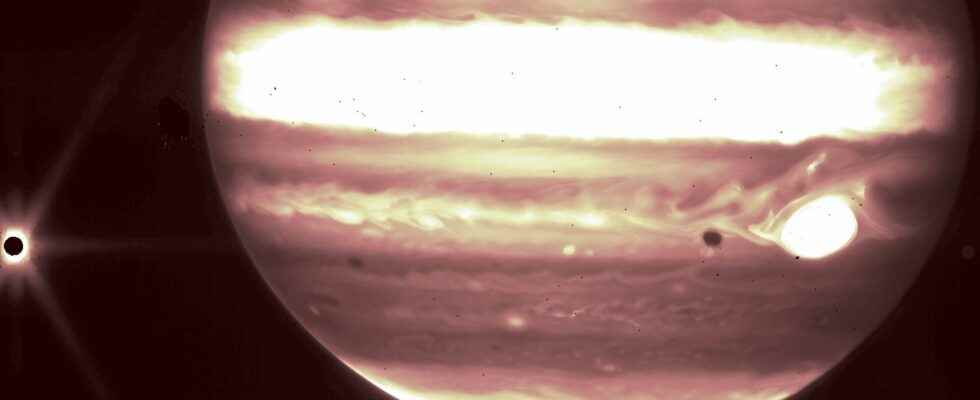The James Webb Space Telescope didn’t just probe celestial objects millions or billions of light-years away, it also pointed its large mirror at Jupiter and its potentially habitable moon, Europa. Again, the result exceeds the expectations of astronomers.
The first images of James-Webb unveiled on July 12, and effectively inaugurating the scientific campaign of the largest and most powerful space telescope ever launched, amazed us with their discoveries on Tuesday. There’s so much to say about each of them, from the farthest reaches ofUniverse revisited – ” the deepest image of the Universe ever obtained » -, to the planetary nebula from the southern ring, passing through a nebula with its staggering “reliefs” of detail, and not to mention the intertwined galaxies of Stefan’s Quintet, where one can even see stars individual… In short, already iconic images. An impressive leap forward in the details obtained by its instruments for cosmic objects tens of thousands of miles awaylight years… several billion light-years away. And “this is just the beginning! » (this is only the beginning), repeated the astrophysicists who participated in their live presentations by Nasa.
And now, Jupiter!
Another surprise and beauty registered on July 12 in the Mikulski archives of the STSI (Space Telescope Science Institute) as part of the James-Webb commissioning, a familiar and nearby object: Jupiter. The astronomers are delighted and do not hide their admiration for the quality of the images and data obtained.
Curious to see what it would be like to observe such a close and brilliant celestial body, they were not disappointed: these portraits of the largest planet in the Solar system indeed reveal its very discreet rings (image of NIRCam), the moon Europe and the small Metis and Thebes. “The images of Jupiter in the narrowband filters were designed to provide beautiful images of the entire disk of the planet, but the wealth of additional information about very faint objects (Métis, Thebes, the main ring, the mists) in these images taken with about a minute of exposure was a very pleasant surprise”says John Stansberry, who takes care of the NIRCam instrument.
Ok, here’s a for real JWST Jupiter. The read noise (vertical lines) is…significant. But, look, the GRS has its own diffraction spikes. This is the NIRCam data with f322w2-f323n overlaid in red and f212n in sky blue. Bg is grayscale combo of both. pic.twitter.com/VWNXFBLpwE
—Judy Schmidt (@SpaceGeck) July 15, 2022
As it concerns Europeone of the four Galilean satellites of Jupiter (visible in binoculars), we can also see its shadow projected on Jupiter, just to the left of the famous Great Red Spot. This potentially habitable satellite which shelters a global ocean under a thick crust of ice will be a privileged target for astronomers who hope to scrutinize and study its water vapor plumes with the space telescope. “I think that’s just one of the coolest things we’ll be able to do with this telescope in the solar system.”says Stefanie Milam, researcher in planetary sciences at the GSFC (Goddard Space Flight Center) from NASA.
James Webb has not finished surprising us and the scientific images of the Universe will rain down for our greatest pleasure, showing us structures and objects that we had never seen before.
Reading ideas for the summer with Futura?
To celebrate the start of the holidays, we offer you the Mag Futura at the preferential price of 15 € instead of 19 €, i.e. a reduction of 20% !
What is Mag Futura?
- Our first paper journal of more than 200 pages to make science accessible to as many people as possible
- 4 major scientific questions for 2022, from the Earth to the Moon
- Home delivery*
*Special offer valid until July 19. Delivery is made in France (excluding metropolitan France), Switzerland, Belgium.
Interested in what you just read?
